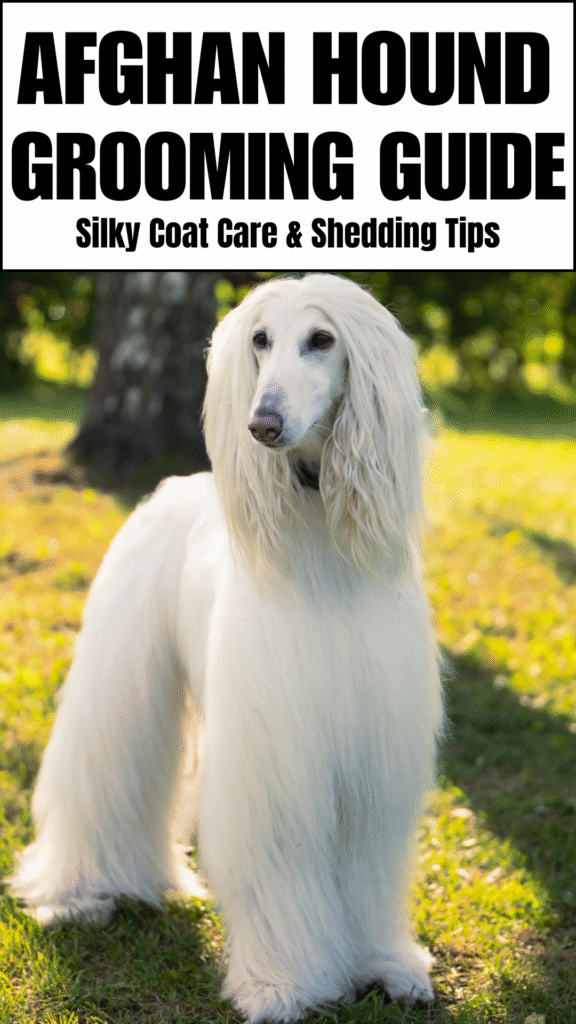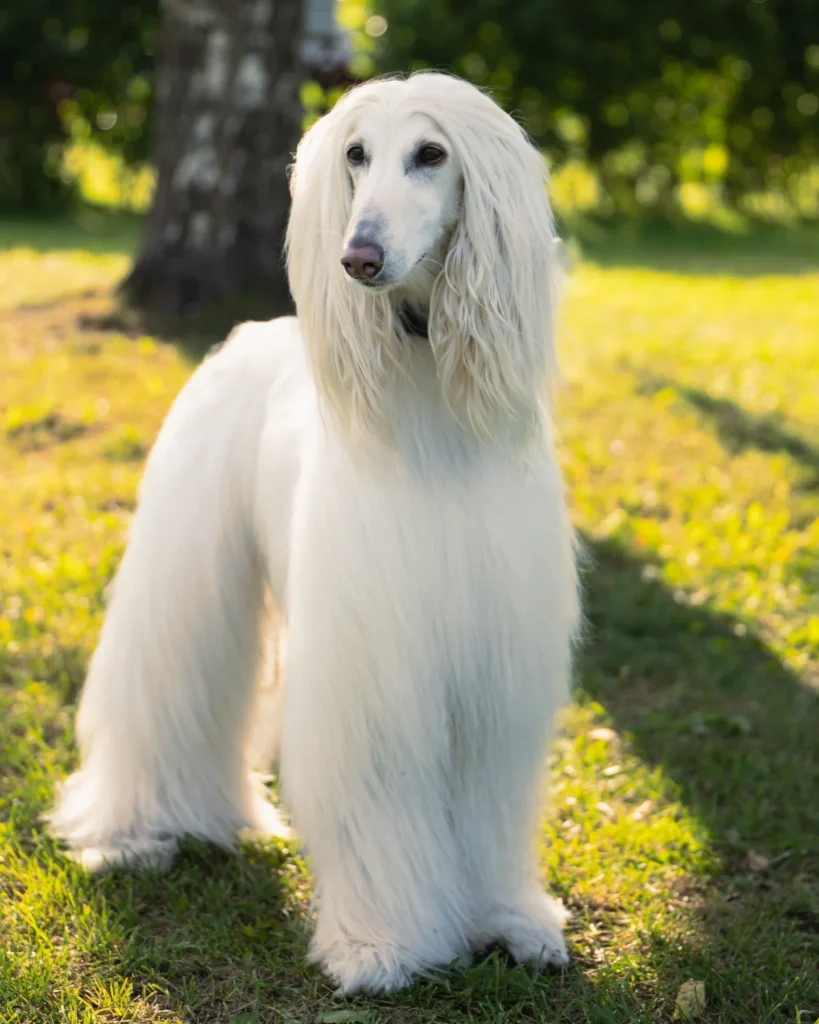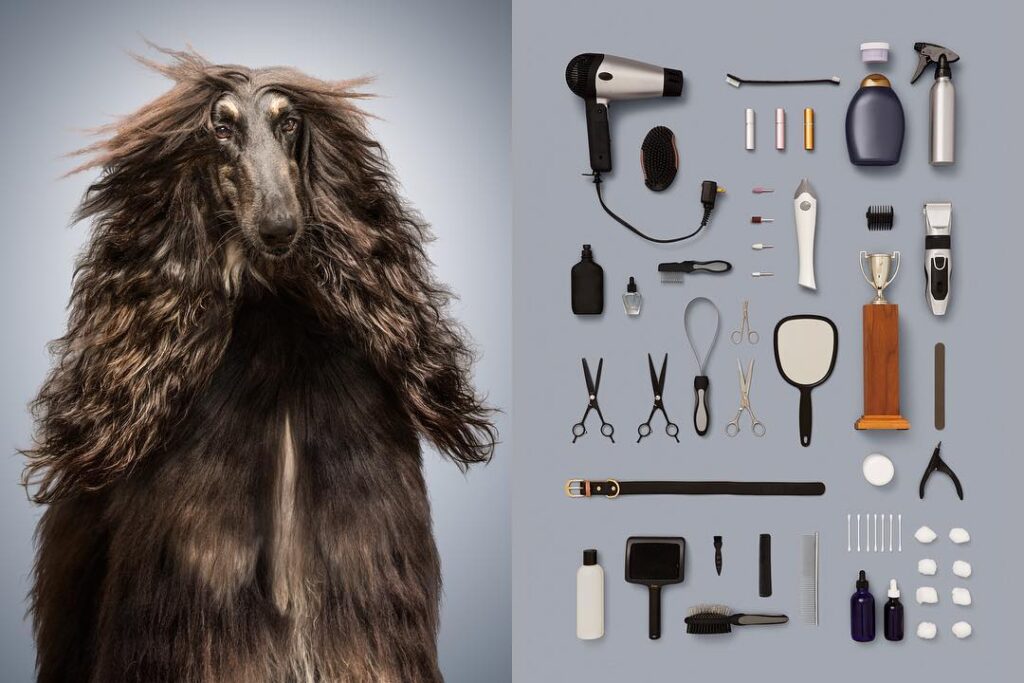If you own an Afghan Hound, you have a dog that’s famous just for its hair.
This breed’s coat isn’t just fur, it’s a long, silky, and unbelievably dense masterpiece that falls like silk ribbons.

It’s what makes your dog look like royalty!
But I can tell you from experience, maintaining this iconic look is a serious, daily chore.
Grooming isn’t just about making them look pretty.
For an Afghan Hound, it’s totally essential for their comfort and health.
If you skip a session, those beautiful strands instantly knot into painful mats that pull on their skin.
That’s bad news for everyone!
This guide will walk you through exactly what I do to keep my dog looking flawless.
You’ll learn about the must-have tools, the correct daily brushing steps, the secrets to bathing this huge amount of hair, and the common mistakes to avoid
Understanding the Afghan Hound Coat

When I first touched my Afghan’s coat, I was amazed.
It truly feels like fine human hair, not coarse like most dog fur.
The hair grows very long over the body, legs, and ears, but it stays shorter and thicker across the back.
This mix of textures is what makes the grooming so challenging.
The biggest headaches come from that delicate texture.
Because the hair is so fine, it tangles and mats the instant it gets friction or moisture.
Simple things like running through wet grass or rolling on the carpet can create knots.
Their long coat also acts like a natural magnet for dirt, leaves, and burrs, especially on the legs.
You must understand this: your dog’s coat type demands daily attention.
A dog with a dense, fine coat like this simply cannot go more than 24 hours without a full brushing.
If your dog is in a show coat, you’ll spend even more time.
The better you understand the coat, the less time you’ll spend crying over tangled messes!
Essential Grooming Tools You’ll Need
I’ve learned the hard way that trying to groom an Afghan Hound without the right gear is impossible.
You will save yourself so much frustration and time by getting these tools right away.
These are the items I keep on hand for every single session:
1. Wide-tooth Comb:
I use this first, before anything else, to gently find the big tangles. It’s your knot-detection device.
2. Pin Brush:
This is the tool I use the most for daily brushing.
Get a good one with smooth pins that won’t scratch your dog’s skin.
It’s perfect for getting through the bulk of the coat without tearing the hair.
3. Slicker Brush:
I use this cautiously, mostly on the shorter hair areas like the top knot or feet.
It’s too harsh for the body, but great for getting out tiny knots that start near the skin.
4. Detangling Spray:
This is your best friend when you hit a difficult mat.
Always spray the knot first! It helps the strands slip apart, reducing breakage and making the job easier for you and less painful for your dog.
5. Dog-Safe Shampoo and Conditioner:
Do not skimp here! You need a rich, moisturizing conditioner.
That silky coat will strip and break if you use cheap products.
6. Grooming Table (Optional but Helpful):
Trust me, standing over a table is much easier on your back than bending down to the floor.
It also keeps your dog still and focused on the job.
7. High-Velocity Dryer:
If you bathe your Afghan at home, you absolutely need this.
Towel-drying is useless and lets the coat mat up as it dries.
This dryer blows water out of the coat quickly, making bathing go much faster.
Step-by-Step Grooming Routine

I have honed this routine over the years, and following these steps consistently is the only way to manage that massive amount of hair effectively.
Trust me, consistency is everything here.
Brushing: A Daily Commitment
I recommend brushing your Afghan every single day, even if it’s just a partial brush.
I always use a technique called “line brushing,” where you section the hair and brush from the bottom layer upward, all the way down to the skin.
Never brush the top layer only, because this creates knots underneath that you can’t see.
Always hold the hair near the root to reduce tension and stop it from breaking, treating each section with gentle care.
Bathing: The Weekend Project
Bathing is a big event, not a quick rinse.
Plan to bathe your Afghan Hound every one to three weeks, depending on how dirty they get.
Before you even get them wet, you must check for and remove all mats, because water makes knots tighten!
I use a gentle circular motion to wash in the shampoo, focusing on the dirtiest areas like the feet and belly.
Always use a generous amount of conditioner and let it soak in for several minutes before rinsing well.
Drying
This is the most critical step after bathing.
You absolutely cannot let the Afghan coat air dry!
Always use a high-velocity dryer and follow up with a warm, regular human hairdryer to make sure the coat is bone-dry right down to the skin.
As you dry, use a pin brush to gently brush the hair, making sure it dries perfectly straight and tangle-free.
Any dampness left deep inside the coat will cause major matting later.
Detangling
Even with the best care, you will find knots.
Never just yank a brush through a tangle.
I always start by saturating the mat with a detangling spray or a little extra conditioner.
Then, I use the wide-toothed comb to gently pull the knot apart, starting with the very tips of the hair and working my way back toward the skin.
This careful process takes longer, but it saves your dog from pain and keeps the coat full.
Trimming
Afghan Hounds are not clipped, but they do need small touch-ups for hygiene and safety.
I use straight scissors to keep the hair short around the sanitary areas (the butt and genitals) to keep things clean.
I also trim the long hair between the pads of their feet so they have better traction and don’t slip on smooth floors.
You can also tidy up the ends of the ears if they drag too much, but generally, less trimming is better to keep that flowing silhouette.
Seasonal Grooming Considerations
I’ve learned that your grooming routine can’t stay the same all year round; you have to adjust based on the weather outside.
The change in seasons really impacts that massive coat.
Summer Coat Care
When the weather turns hot and humid, my main job is to keep the coat light and cool while preventing mildew and matting.
Humidity makes the hair clump together much faster, so I focus more on the drying process after any swim or bath.
I also check the coat for any hidden dampness near the skin that could cause irritation.
Some owners choose to keep the coat shorter in the summer, but if you keep it long, you need to be extra religious with your daily line-brushing.
Winter Coat Care
In the winter, the coat tends to get thicker and heavier, and it’s always wet from rain or snow.
My priority shifts to protecting the coat from damage and keeping it dry.
I put a lot more moisturizing conditioner into the coat during baths because the dry winter air can make the hair brittle and cause breakage.
I also use a dog coat or sweater when we go out in bad weather to act as a barrier.
This keeps the chest and belly fur out of the muck and preventing huge, crusty tangles from forming.
Professional Grooming vs. At-Home Grooming
I’ve learned that even the most dedicated owner can’t do it all, and it’s smart to know when to call in a professional.
It’s a balance of effort, skill, and money.
Benefits of Professional Grooming
Even though I brush daily, I still take my Afghan Hound to a groomer who specializes in long-haired breeds.
The huge benefit is that pros have powerful tools and techniques you don’t have at home.
They can get the coat cleaner and dryer than you can, and they can spot early signs of skin issues or matting you might miss.
Regular professional baths and blowouts make your daily brushing job so much easier.
Cost Considerations
Let me be honest: professional grooming for an Afghan Hound is expensive.
Because of the sheer volume of hair and the careful handling required, expect to pay a premium price for a full bath and fluff every few weeks.
You must factor this into your budget before you ever bring one of these dogs home.
Trying to save money by skipping these sessions will only lead to huge, painful mats that require even more costly emergency shaving later.
When to Call in a Pro
I call my groomer when I know the coat is getting too thick to manage, or if I find a mat that is simply too close to the skin for me to safely remove.
You should also call a pro if you are going on a long trip and want the coat in perfect shape before you leave.
Basically, if you feel overwhelmed, frustrated, or notice hard, felt-like patches forming, it’s time to call the expert.
Don’t wait until the matting becomes a huge, painful problem for your dog.
Conclusion
I hope this guide has given you a real understanding of the work involved.
Owning an Afghan Hound is truly a labor of love, and most of that labor happens during your daily grooming session.
I won’t lie: maintaining this coat is a huge commitment.
It demands time, quality products, and endless patience.
You will sometimes feel frustrated, and you will definitely spend more time brushing hair than watching TV.
But remember the reward: there is nothing quite like the sight of a perfectly groomed Afghan Hound moving with that incredible, silky, flowing grace.
Your dedication to the brush ensures your dog is not just beautiful, but happy, comfortable, and healthy.
Don’t let the task overwhelm you.
Stick to your daily line-brushing routine, invest in the best conditioner you can afford, and never let the coat air dry.
If you follow these steps, you’ll master the art of Afghan Hound grooming and keep your royal companion looking absolutely flawless.